Centrifugal Compressor Stall Control by the Application of Engineered Surface Roughness on Diffuser Shroud Using Numerical Simulations
Abstract
1. Introduction
Scope of the Paper
2. Baseline Compressor Specifications
The Wall Surface Roughness
- Hydraulically smooth region (0 < K+ < 5), in this region the size of the grain is too small and it has no significant impact on the performance of the compressor;
- Transition region (5 < K+ < 70), in this region the sand grain/roughness elements are great enough to project out of closest layer to wall and further resistance is observed because of high surface roughness;
- Completely rough region (K+ > 70), in this region all the sand grain/roughness heights project out of the viscous sublayer and drag form of resistance is offered.
3. Numerical Setup
3.1. Modelling in BladeGen Using Geometric Parametrization
3.2. Meshing in TurboGrid
3.3. Turbulence Model
3.4. Boundary Conditions and Numerical Setup
4. Results and Discussion
4.1. Validation of Experimental Data
- K-ε and SST Turbulence models are used for validation;
- Simulations conditions: mass flowrate 2.55 kg/s and design rotational speed;
4.2. Influence of Surface Roughness on the Diffuser Flow Structure
4.3. Entropy Generation
5. Conclusions
- The compressor has shown peak performance when operated at low mass flow on hydraulically smooth surfaces, which plays important role in the stall margin and operating range of the compressor. At low mass flow rate compressor showed flow instabilities at diffuser inlet.
- To control the flow instabilities, surface roughness has been applied on diffuser shroud to suppress flow separation and hence, stall phenomena.
- The validation results showed overprediction of 2.3% and 8% for SST and k-ε turbulence models, respectively.
- The application of surface roughness increased the operating range from 16% to 18% and stall margin increased from 5.6% to 7.9% by controlling flow separation and flow recirculation effects.
- Based on current analysis, the most efficient design is compressor with surface roughness magnitude of 200 μm, as it completely eliminated the stall phenomena.
- The percentage drop in pressure ratio at stall point for 50 μm is 3.3%, 4.2% for 100 μm and 5.08% for 200 μm using k-ω SST turbulence model.
- The prime contributor to the entropy generation is the relatively high velocity flow in diffuser section with surface roughness applied on the diffuser shroud.
- Entropy generation increased by 3.5%, 3.7% and 3.9% for 50 μm, 100 μm and 200 μm, respectively, due to increased frictional losses and boundary layer thickness.
- Even though, it is clear from the aerodynamics of the compressor that at low mass flow rate, application of surface roughness reduces secondary flow but due to the increased surface roughness, viscous shear stresses deteriorate the performance.
- It is also observed increasing surface roughness increases the percent drop in tangential velocity, and hence increases the frictional losses that leads to the deterioration of the centrifugal compressor performance.
6. Future Recommendations
Author Contributions
Funding
Institutional Review Board Statement
Informed Consent Statement
Data Availability Statement
Acknowledgments
Conflicts of Interest
References
- Davis, S.J.; Caldeira, K.; Matthews, H.D. Future CO2 Emissions and Climate Change from Existing Energy Infrastructure. Science (80-) 2010, 329, 1330–1333. [Google Scholar] [CrossRef] [PubMed]
- Xue, X.; Wang, T.; Zhang, T.; Yang, B. Mechanism of stall and surge in a centrifugal compressor with a variable vaned diffuser. Chin. J. Aeronaut. 2018, 31, 1222–1231. [Google Scholar] [CrossRef]
- Mathew, D.; Farshid, S. Investigation of Turbocharger Dynamics Using a Combined Explicit Finite and Discrete Element Method Rotor–Cartridge Model. J. Tribol. 2016, 139, 1–8. [Google Scholar] [CrossRef]
- Gravdahl, J.T. Modeling and control of surge and rotating stall in compressors. Sci. Technol. 1998, 141. [Google Scholar]
- Tan, C.S.; Day, I.; Morris, S.; Wadia, A. Spike-Type Compressor Stall Inception, Detection, and Control. Annu. Rev. Fluid Mech. 2010, 42, 275–300. [Google Scholar] [CrossRef]
- Moore, F.K.; Greitzer, E.M. A theory of post-stall transients in axial compression systems: Part 1—development of equations. J. Eng. Gas Turbines Power 1986, 108, 68–76. [Google Scholar] [CrossRef]
- Young, A.M.; Cao, T.; Day, I.J.; Longley, J.P. Accounting for Eccentricity in Compressor Performance Predictions. Vol. 5C Heat Transf. 2016, 139, 1–27. [Google Scholar] [CrossRef]
- Greitzer, E.M. Surge and Rotating Stall in Axial Flow Compressors—1, 2. Am. Soc. Mech. Eng. 1975, (75-GT-9), 190–198. [Google Scholar]
- Camp, T.R.; Day, I.J. 1997 Best Paper Award—Turbomachinery Committee: A Study of Spike and Modal Stall Phenomena in a Low-Speed Axial Compressor. J. Turbomach. 1998, 120, 393–401. [Google Scholar] [CrossRef]
- Zheng, X.; Sun, Z.; Kawakubo, T.; Tamaki, H. Experimental investigation of surge and stall in a turbocharger centrifugal compressor with a vaned diffuser. Exp. Therm. Fluid Sci. 2017, 82, 493–506. [Google Scholar] [CrossRef]
- Stein, A.; Niazi, S.; Sankar, L.N. Computational analysis of stall and separation control in centrifugal compressors. J. Propuls. Power 2000, 16. [Google Scholar] [CrossRef]
- Feulner, M.R.; Hendricks, G.J.; Paduano, J.D. Modeling for Control of Rotating Stall in High Speed Multi-Stage Axial Compressors. Proc. ASME Turbo Expo. 1994, 5. [Google Scholar] [CrossRef]
- Zhang, Y.; Lu, X.; Zhang, Y.; Han, G.; Zhu, J. Parametric study of slotted diffuser effects on a highly loaded centrifugal compressor. Proc. Inst. Mech. Eng. Part A J. Power Energy 2019, 0, 1–13. [Google Scholar] [CrossRef]
- Gi, B. Scaling laws for fully developed turbulent shear flows. Part 1. Basic hypotheses and analysis. J. Fluid Mech. 1993, 248, 513–520. [Google Scholar]
- Bergstrom, D.J.; Kotey, N.A.; Tachie, M.F. The Effects of Surface Roughness on the Mean Velocity Profile in a Turbulent Boundary Layer. J. Fluids Eng. 2002, 124, 664–670. [Google Scholar] [CrossRef]
- Bandyopadhyay, P.R.; Watson, R.D. Structure of rough-wall turbulent boundary layers. Phys. Fluids 1988, 31, 1877. [Google Scholar] [CrossRef]
- Krogstad, B.P.; Antonia, R.A. Comparison between rough- and smooth-wall turbulent boundary layers. J. Fluid Mech. 1992, 245, 599–617. [Google Scholar] [CrossRef]
- Raupach, M.R.; Antonia, R.A.; Rajagopalan, S. Rough-Wall Turbulent Boundary Layers. Appl. Mech. Rev. 1991, 44, 1–25. [Google Scholar] [CrossRef]
- Isaacson, L.K. Entropy Generation through the Interaction of Laminar Boundary-Layer Flows: Sensitivity to Initial Conditions. J. Mod. Phys. 2018, 9, 1660–1689. [Google Scholar] [CrossRef][Green Version]
- Ullah, T.; Ahmad, F.; Siddiqi, M.U.R.; Hanif, M.I.; Irfan, M.; Khan, A.H.; Ali, S. Blade Meridional Profile Optimization for Novel High-Pressure Ratio Centrifugal Compressor Design Using Numerical Simulations. In Proceedings of the 2020 3rd International Conference on Computing, Mathematics and Engineering Technologies (iCoMET), Sukkur, Pakistan, 29 January–30 January 2020. [Google Scholar]
- Khan, A.; Siddiqi, M.U.; Ahmad, F. Numerical Investigation of Transonic High-Pressure Ratio Centrifugal Compressor. J. Turbomach. 2020, 16, 83–95. [Google Scholar]
- Simpson, R.L. A generalized correlation of roughness density effects on the turbulent boundary layer. AIAA J. 1973, 11, 242–244. [Google Scholar] [CrossRef]
- Jonáš, P.; Hladík, O.; Mazur, O.; Uruba, V. By-pass transition of flat plate boundary layers on the surfaces near the limit of admissible roughness. J. Phys. Conf. Ser. 2011, 318, 032030. [Google Scholar] [CrossRef]
- Strub, R.A.; Sterkrade, M. Influence of the Reynolds Number on the Performance of Centrifugal Compressors. J. Turbomach. 1987, 109, 541–544. [Google Scholar] [CrossRef]
- Čep, R.; Janásek, A.; Petrů, J.; Sadilek, M.; Mohyla, P.; Valíček, J.; Harničárová, M.; Czán, A. Surface Roughness after Machining and Influence of Feed Rate on Process. Key Eng. Mater. 2013, 581, 341–347. [Google Scholar] [CrossRef]
- Feldshtein, E.; Józwik, J.; Legutko, S. The influence of the conditions of emulsion mist formation on the surface roughness of aisi 1045 steel after finish turning. Adv. Sci. Technol. Res. J. 2016, 10, 144–149. [Google Scholar] [CrossRef]
- Khan, A.; Ullah, T. Numerical Analysis of Flow Through High Pressure Ratio Centrifugal Compressor Impeller and Effect of Varying Diffuser Exit Width on Performance. Int. J. Eng. Work. 2019, 6, 399–405. [Google Scholar] [CrossRef]
- Kapoor, P. Influence of Surface Roughness on Flow Instabilities in a Centrifugal Compressor. Master Thesis, Delft University of Technology, Delft, The Netherlands; pp. 1–24.
- Hodge, B.K.; Taylor, R.P. A Re-Evaluation of Schlichting’s Surface Roughness Experiment. J. Fluid Eng. 2016, 106, 60–65. [Google Scholar]
- Launder, B.E.; SD, B. MAN—ANSYS Fluent User’ s Guide Releasde 15.0. Knowl. Creat. Diffus. Util. 2013, 15317, 724–746. [Google Scholar]
- Khan, A.; Ahmad, F.; Ali, S.; Siddiqi, M.R.; Ijaz, Z. Novel Simplified Blade Hub Line Optimization of High-Pressure Ratio Centrifugal Compressor Design Using Numerical Simulations Novel Simplified Blade Hub Line Optimization of High-Pressure Ratio Centrifugal Compressor Design Using Numerical Simulations. In IOP Conference Series: Material Sciences and Engineering; IOP Publishing: Bristol, UK, 2020. [Google Scholar]
- Krain, H.; Hoffmann, B.; Pak, H. Aerodynamics of a Centrifugal Compressor Impeller with Transonic Inlet Conditions. Proc. ASME Turbo Expo. 1995, 1. [Google Scholar] [CrossRef]
- Galloway, L.; Spence, S.; Rusch, D.; Vogel, K.; Hunziker, R. An investigation of the stability enhancement of a centrifugal compressor stage using a porous throat diffuser. J. Turbomach. 2018, 140, 011008. [Google Scholar] [CrossRef]
- Tian, C.; Lu, Y. Turbulence Models of Separated Flow in Shock Wave Thrust Vector Nozzle turbulence models of separated flow in shock wave. Eng. Appl. Comput. Fluid Mech. 2014, 7, 182–192. [Google Scholar]
- Ghigliazza, F.; Traverso, A.; Ferrari, M.L.; Wingate, J. An optimization technique for radial compressor impellers. In Turbo Expo: Power for Land, Sea, and Air; Gt2008-50562; Asme: New York, NY, USA, 2008; pp. 2401–2411. [Google Scholar]
- Eisenlohr, G.; Dalbert, P.; Krain, H.; Pröll, H.; Richter, F.-A.; Rohne, K.-H. Analysis of the Transonic Flow at the Inlet of a High Pressure Ratio Centrifugal Impeller. In Turbo Expo: Power for Land, Sea, and Air; American Society of Mechanical Engineers: New York, NY, USA, 1998; Volume 78620, p. V001T01A007. [Google Scholar]
- Eckardt, D. Instantaneous Measurements in the Jet-Wake Discharge Flow of a Centrifugal Compressor Impeller. J. Eng. Power 1975, 97, 337–345. [Google Scholar] [CrossRef]
- Eckardt, D. Detailed Flow Investigations within a High-Speed Centrifugal Compressor Impeller. J. Fluids Eng. 1976, 98, 390–399. [Google Scholar] [CrossRef]
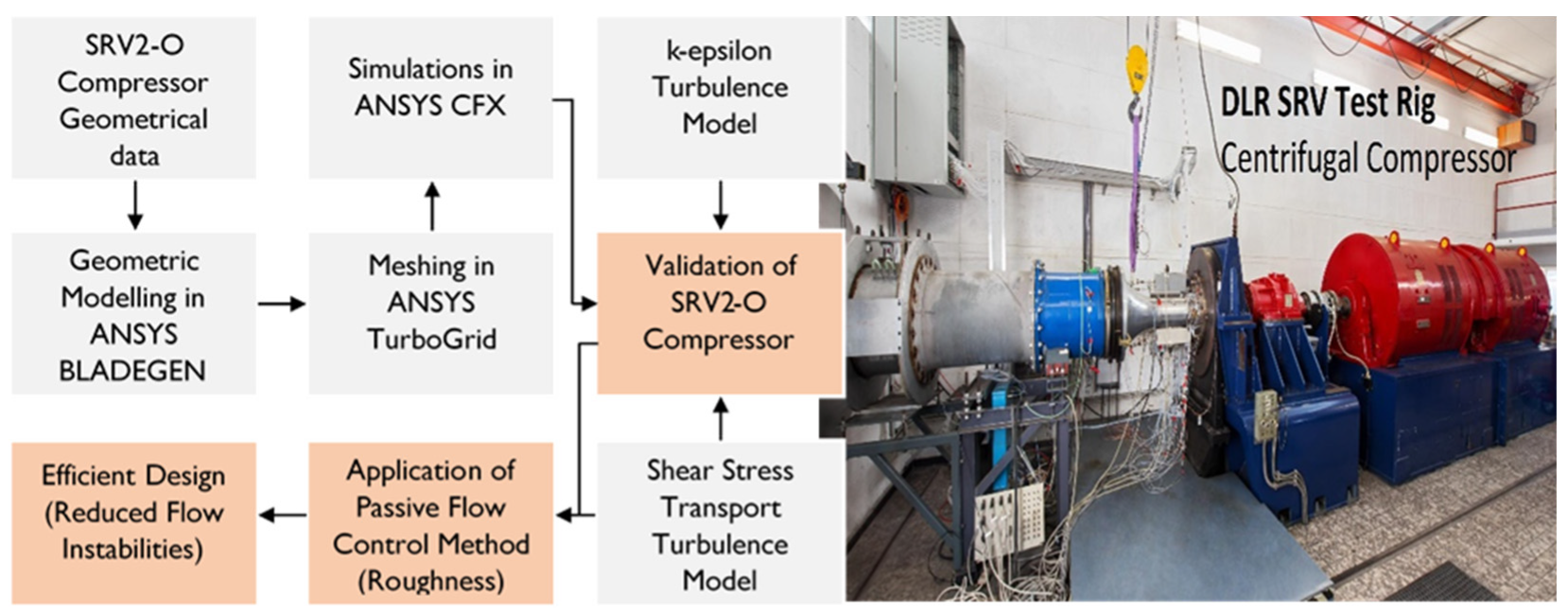
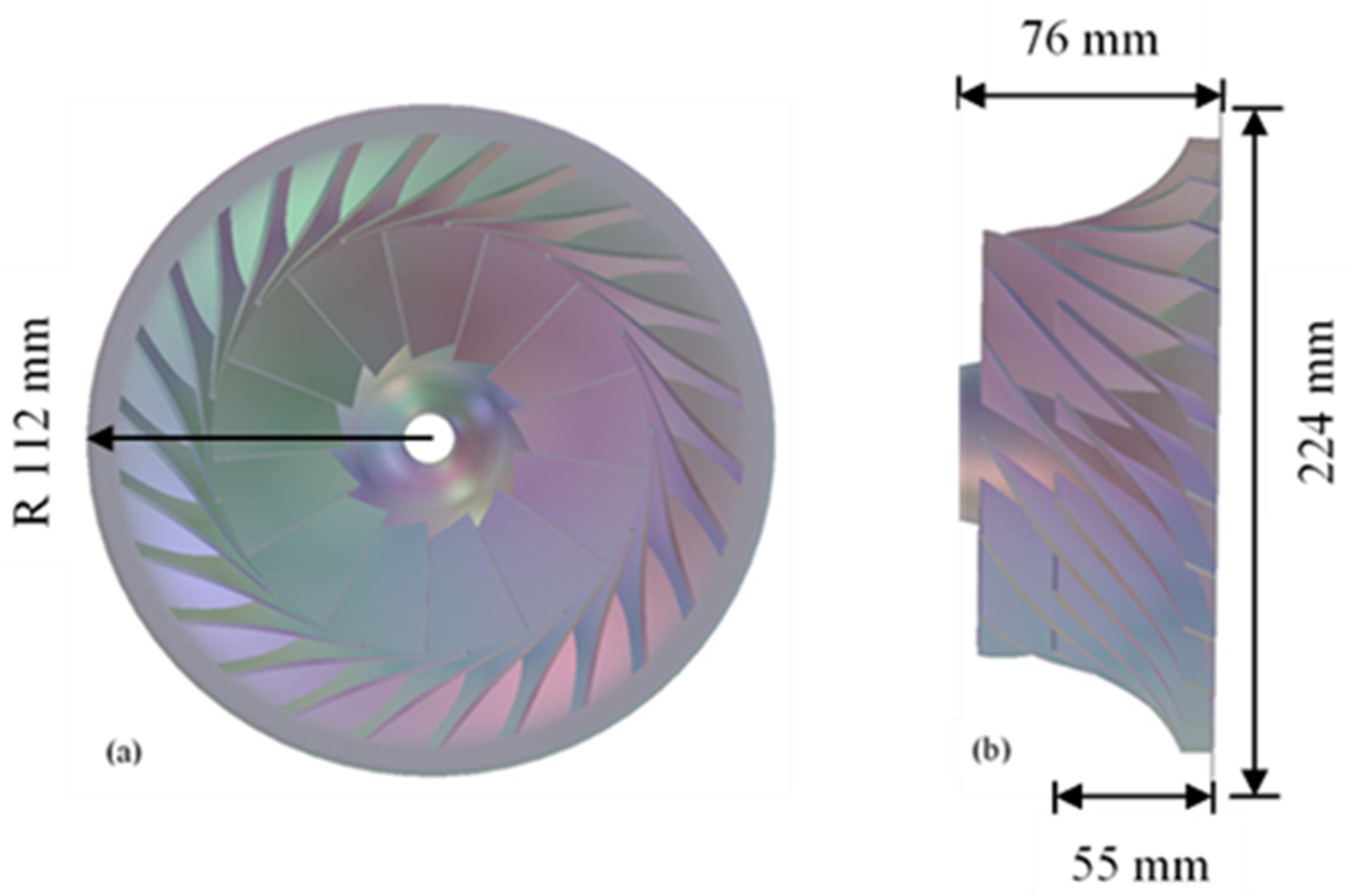

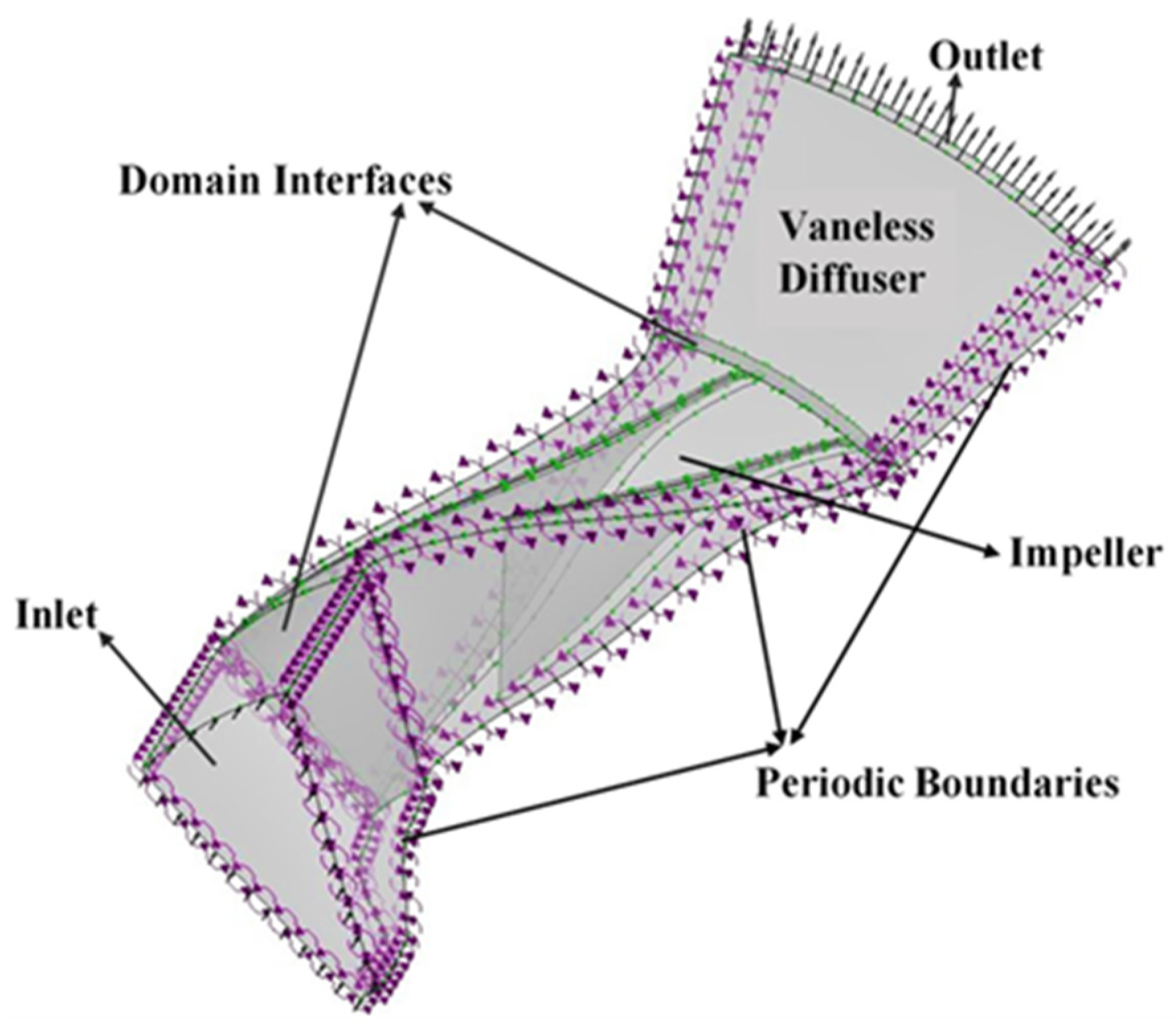
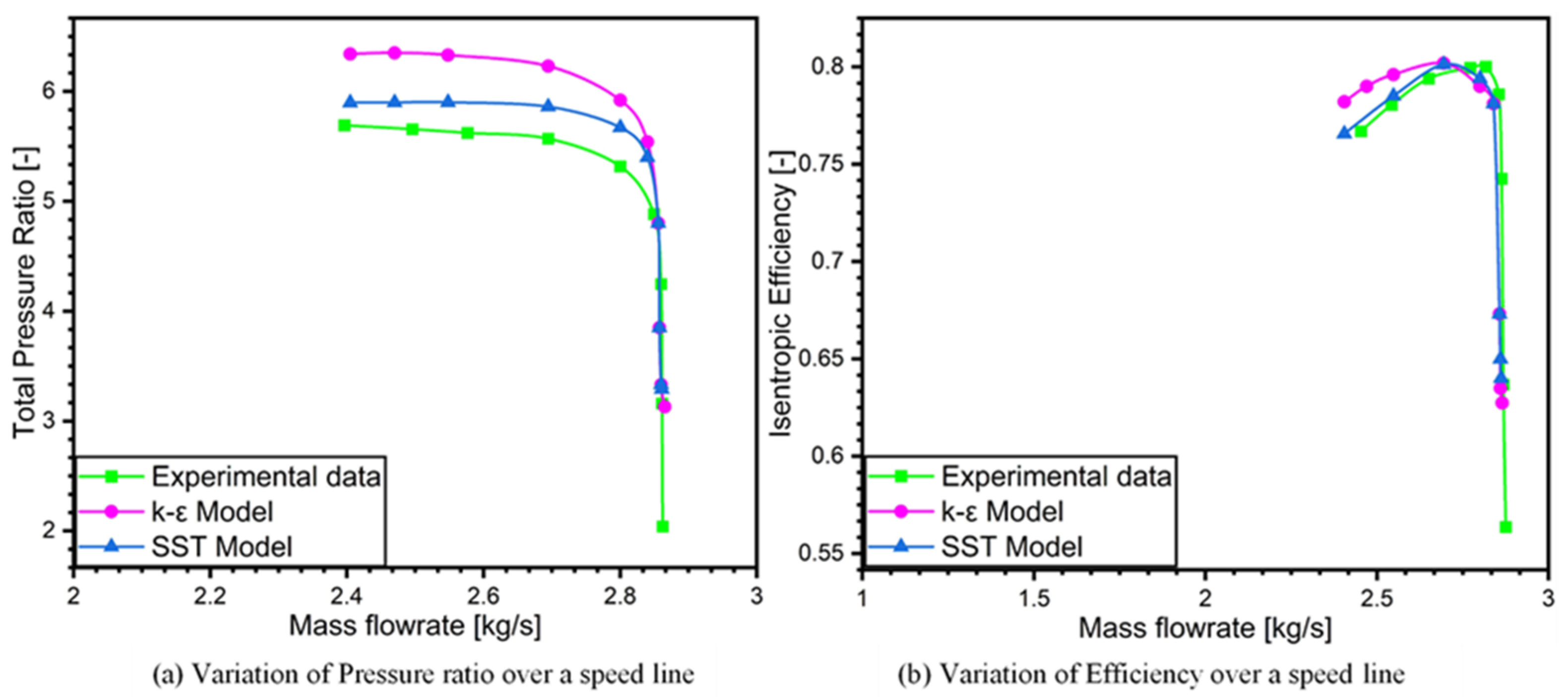
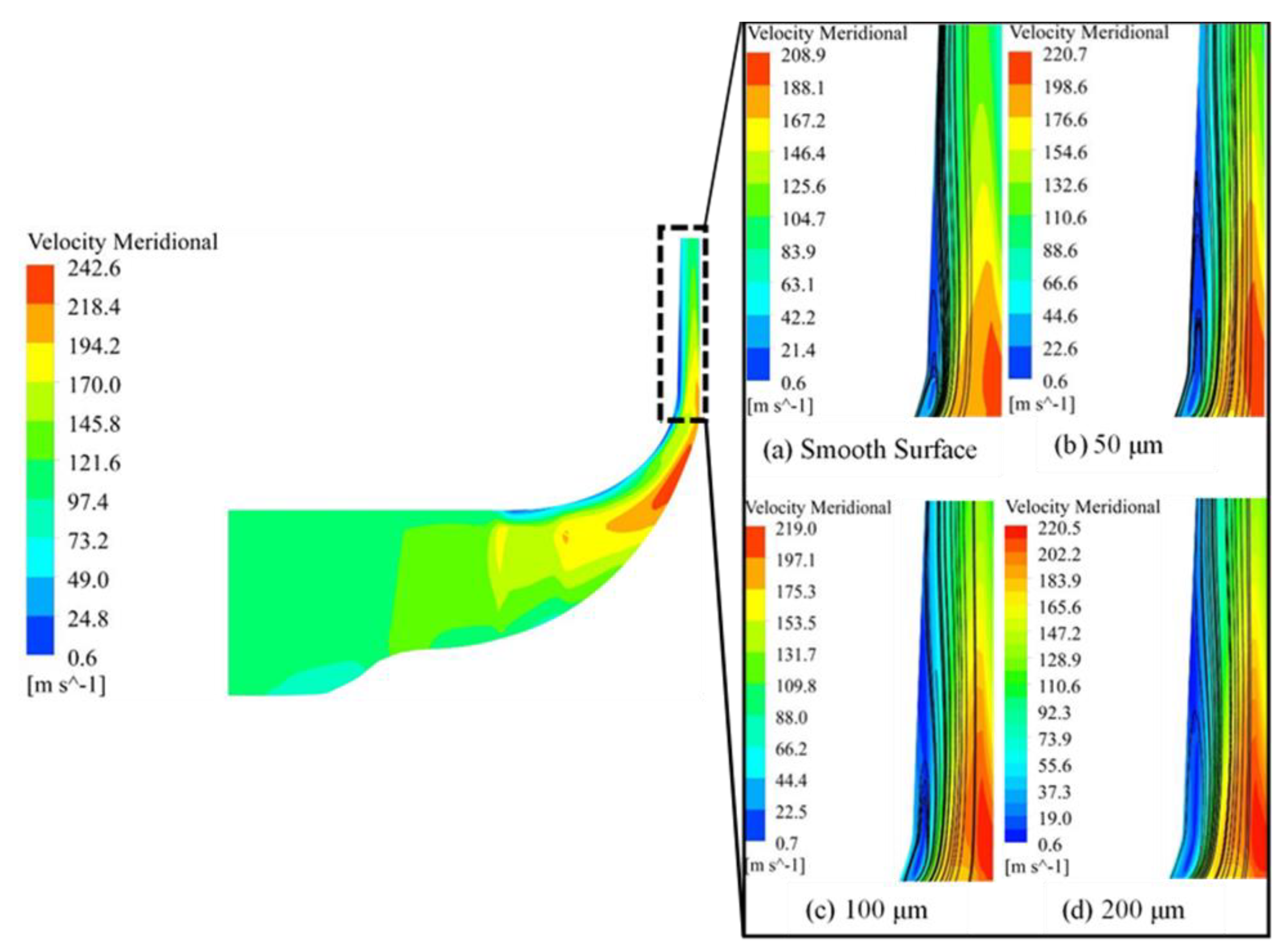
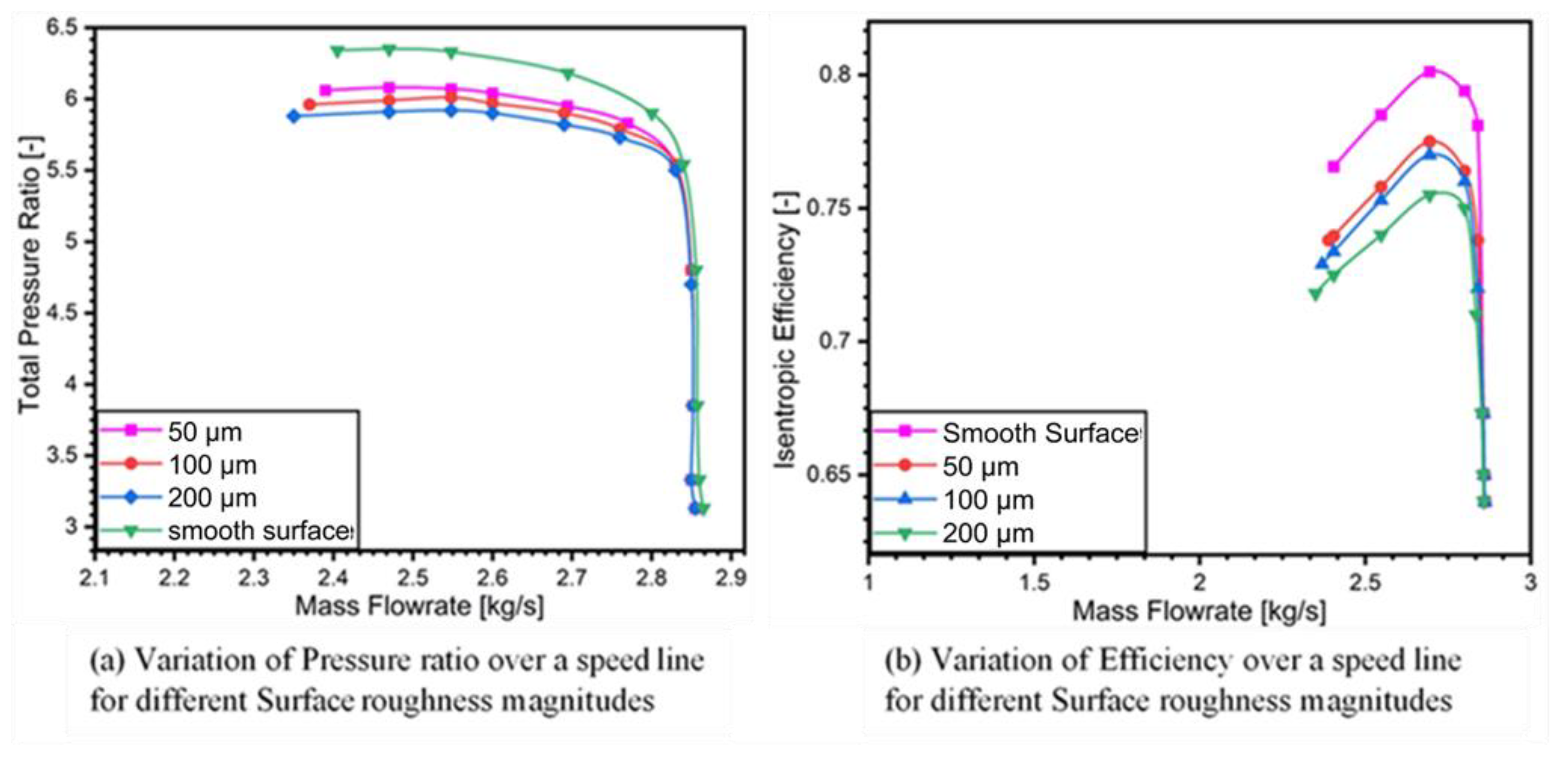
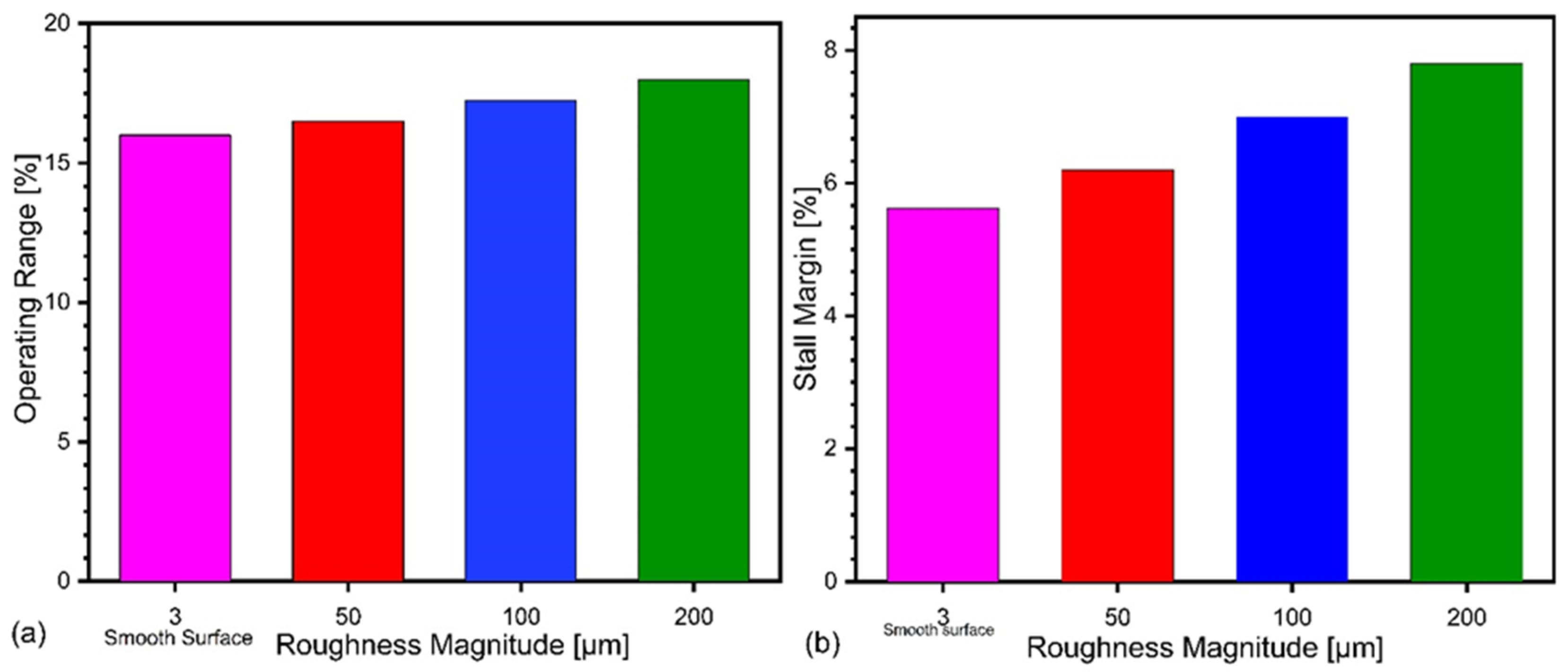

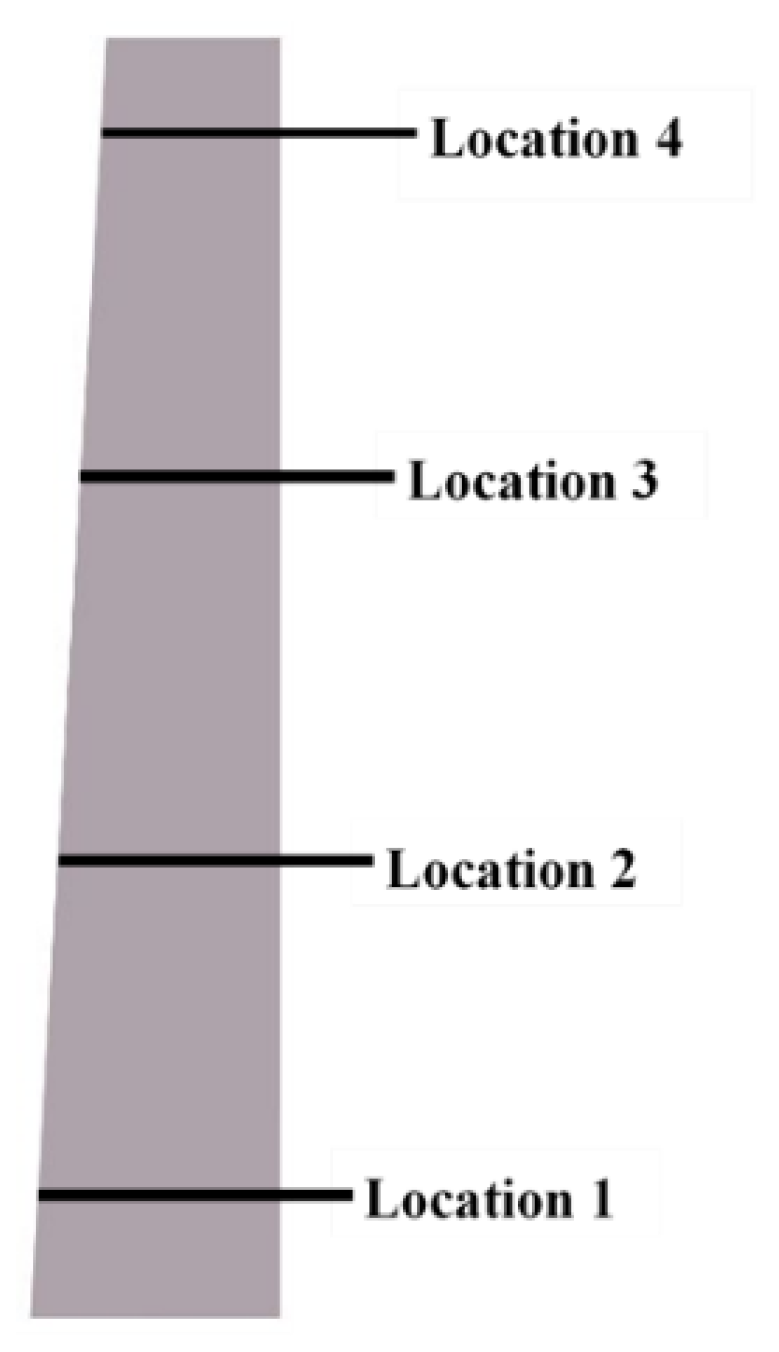
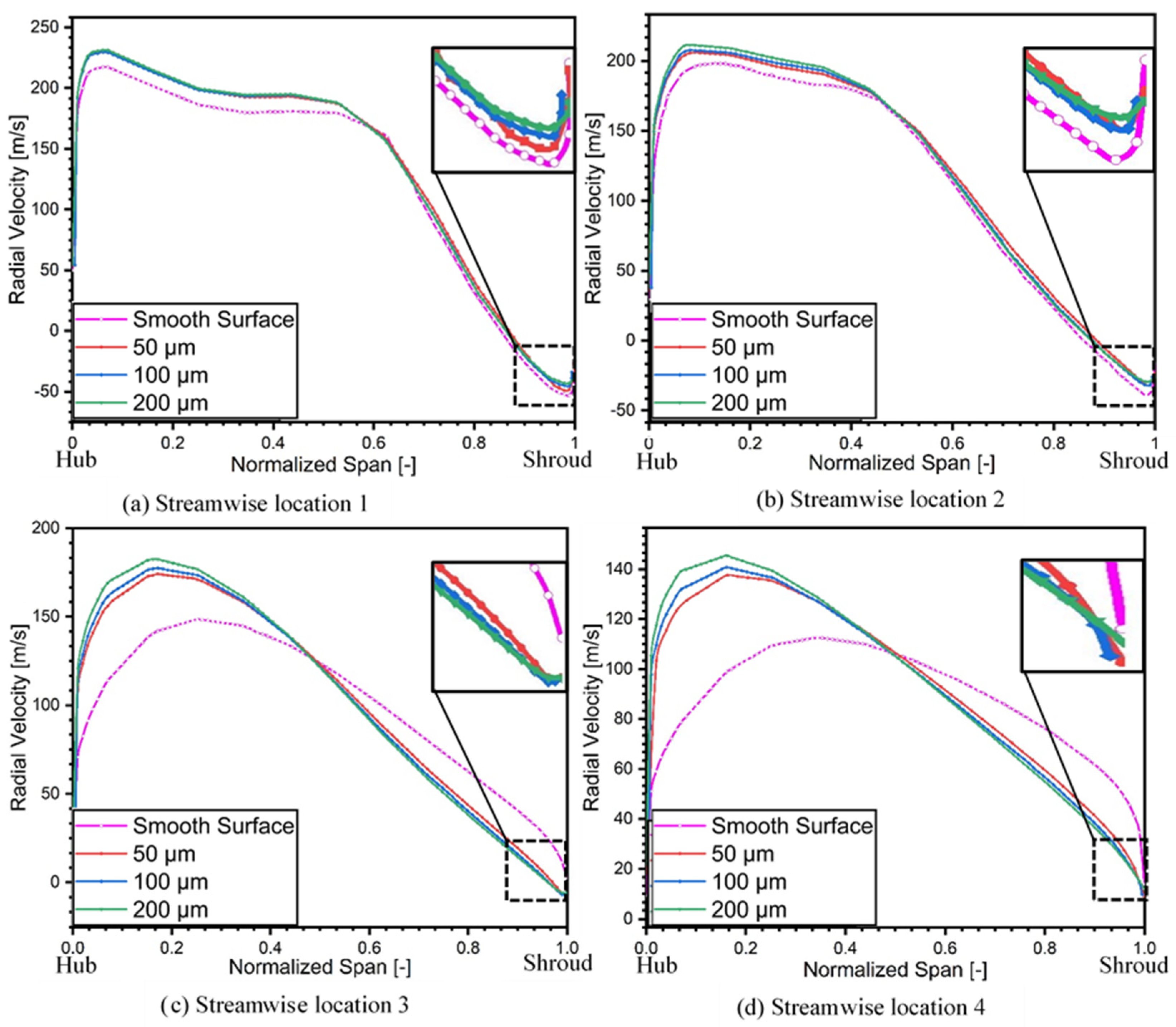
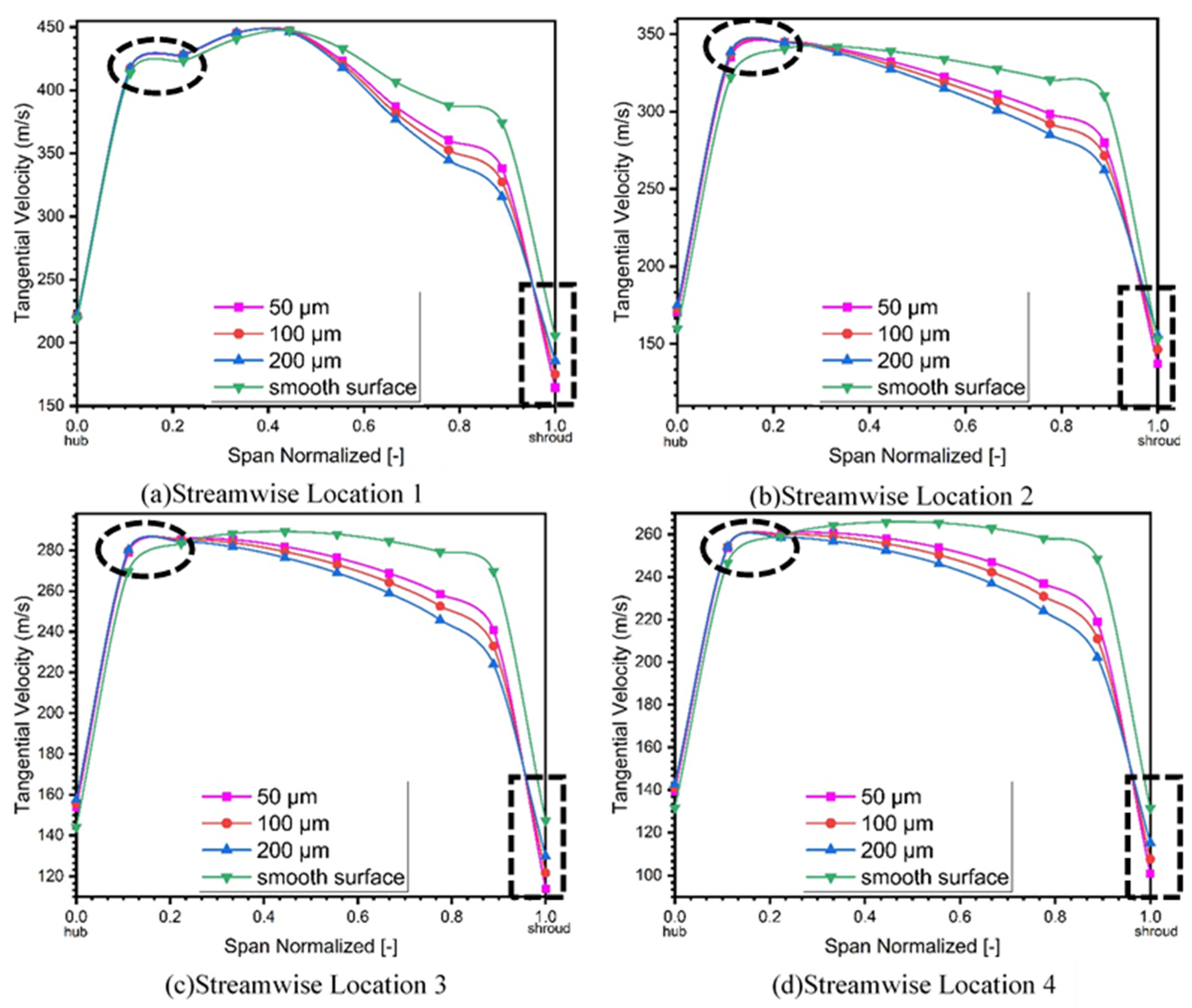

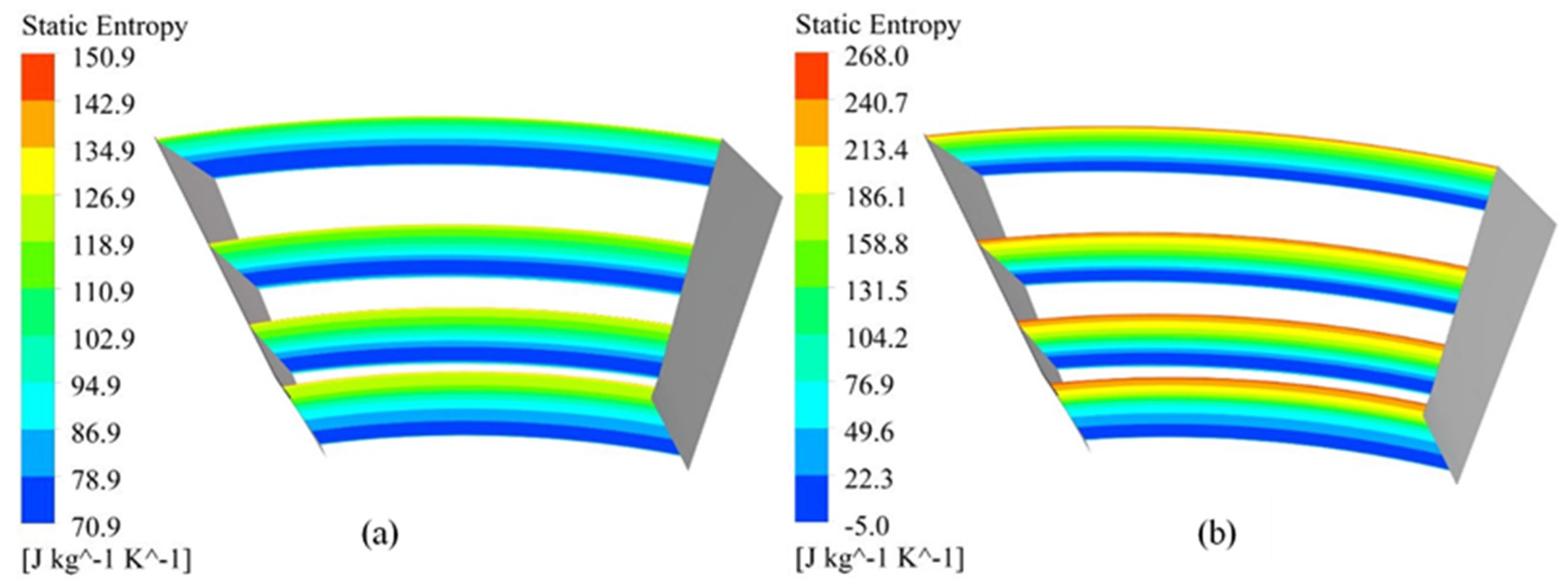
| Parameter | Value | Unit |
|---|---|---|
| Inlet pressure, Pt1 | 101.3 | [kPa] |
| Inlet temperature, Tt1 | 15 | [°C] |
| Rotational speed, n | 50,000 | [rpm] |
| Mass flowrate at design point, m | 2550 | [g/s] |
| Blade flow-angle at inlet (β1) | 26.5 | degree |
| Impeller blade tip-speed | 586 | [m/s] |
| Impeller pressure-ratio | 5.8 | - |
| Isentropic efficiency | 84% | - |
| Full and Splitter blades count | 13:13 | - |
| Blade flow-angle at outlet (β2) | 52 | degree |
| Scheme 1. | Roughness Height (μm) |
|---|---|
| 1 | 50 |
| 2 | 100 |
| 3 | 200 |
Publisher’s Note: MDPI stays neutral with regard to jurisdictional claims in published maps and institutional affiliations. |
© 2021 by the authors. Licensee MDPI, Basel, Switzerland. This article is an open access article distributed under the terms and conditions of the Creative Commons Attribution (CC BY) license (https://creativecommons.org/licenses/by/4.0/).
Share and Cite
Khan, A.; Irfan, M.; Niazi, U.M.; Shah, I.; Legutko, S.; Rahman, S.; Alwadie, A.S.; Jalalah, M.; Glowacz, A.; Khan, M.K.A. Centrifugal Compressor Stall Control by the Application of Engineered Surface Roughness on Diffuser Shroud Using Numerical Simulations. Materials 2021, 14, 2033. https://doi.org/10.3390/ma14082033
Khan A, Irfan M, Niazi UM, Shah I, Legutko S, Rahman S, Alwadie AS, Jalalah M, Glowacz A, Khan MKA. Centrifugal Compressor Stall Control by the Application of Engineered Surface Roughness on Diffuser Shroud Using Numerical Simulations. Materials. 2021; 14(8):2033. https://doi.org/10.3390/ma14082033
Chicago/Turabian StyleKhan, Amjid, Muhammad Irfan, Usama Muhammad Niazi, Imran Shah, Stanislaw Legutko, Saifur Rahman, Abdullah Saeed Alwadie, Mohammed Jalalah, Adam Glowacz, and Mohammad Kamal Asif Khan. 2021. "Centrifugal Compressor Stall Control by the Application of Engineered Surface Roughness on Diffuser Shroud Using Numerical Simulations" Materials 14, no. 8: 2033. https://doi.org/10.3390/ma14082033
APA StyleKhan, A., Irfan, M., Niazi, U. M., Shah, I., Legutko, S., Rahman, S., Alwadie, A. S., Jalalah, M., Glowacz, A., & Khan, M. K. A. (2021). Centrifugal Compressor Stall Control by the Application of Engineered Surface Roughness on Diffuser Shroud Using Numerical Simulations. Materials, 14(8), 2033. https://doi.org/10.3390/ma14082033








